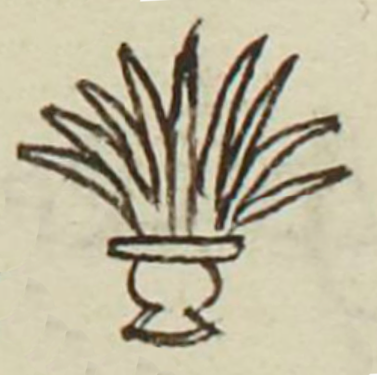Xelhuan (MH536r)
This black-line drawing of the simplex glyph represents the personal name Xelhuan (also spelled Xelhua). The glyph appears to be a European-style pot with a spiky plant with nine leaves or a group of quetzal feathers possibly made into a headdress (see below for comparisons). Perhaps the items in the pot are meant to be distributed (relating to the verb, xeloa).
Stephanie Wood
Xelhua or Xelhuan was the name of a a figure in Nahua origin stories who has been interpreted as a mythical giant, prince, or "deity," the son of Ilancueitl, and someone active in the Tehuacan Valley. [See Emily Umberger, "Aztec Presence and Material Remains in the Outer Provinces," in Aztec Imperial Strategies, ed. Frances Berdan (1996, 170).] He may have climbed Mount Tlaloc to escape a flood, and some attribute him with organizing the construction of the huge pyramid in Cholula. Our Online Nahuatl Dictionary also reports that Xelhuan was the name of: "a Nonoalca Chichimeca who settled in Tula with three other Nonoalcas and four Tolteca Chichimecas, according to the Historia Tolteca Chichimeca or Anales de Cuauhtinchan." A feathered headdress would align with memories of the Chichimeca people that were held by sedentary central Mexicans.
Stephanie Wood
digo xelhuā
Diego Xelhua
Stephanie Wood
1560
Jeff Haskett-Wood
distribute, distribuir, divide, dividir, counters, marcadores, feathers, plumas

Xelhuan, name, https://nahuatl.wired-humanities.org/content/xelhuan
xeloa, to divide or distribute, https://nahuatl.wired-humanities.org/content/xeloa
(el nombre de un ancestro Chichimeca)
Stephanie Wood
Matrícula de Huexotzinco, folio 536r, https://www.loc.gov/resource/gdcwdl.wdl_15282/?sp=151&st=image
This manuscript is hosted by the Library of Congress and the World Digital Library; used here with the Creative Commons, “Attribution-NonCommercial-ShareAlike 3.0 License” (CC-BY-NC-SAq 3.0).








